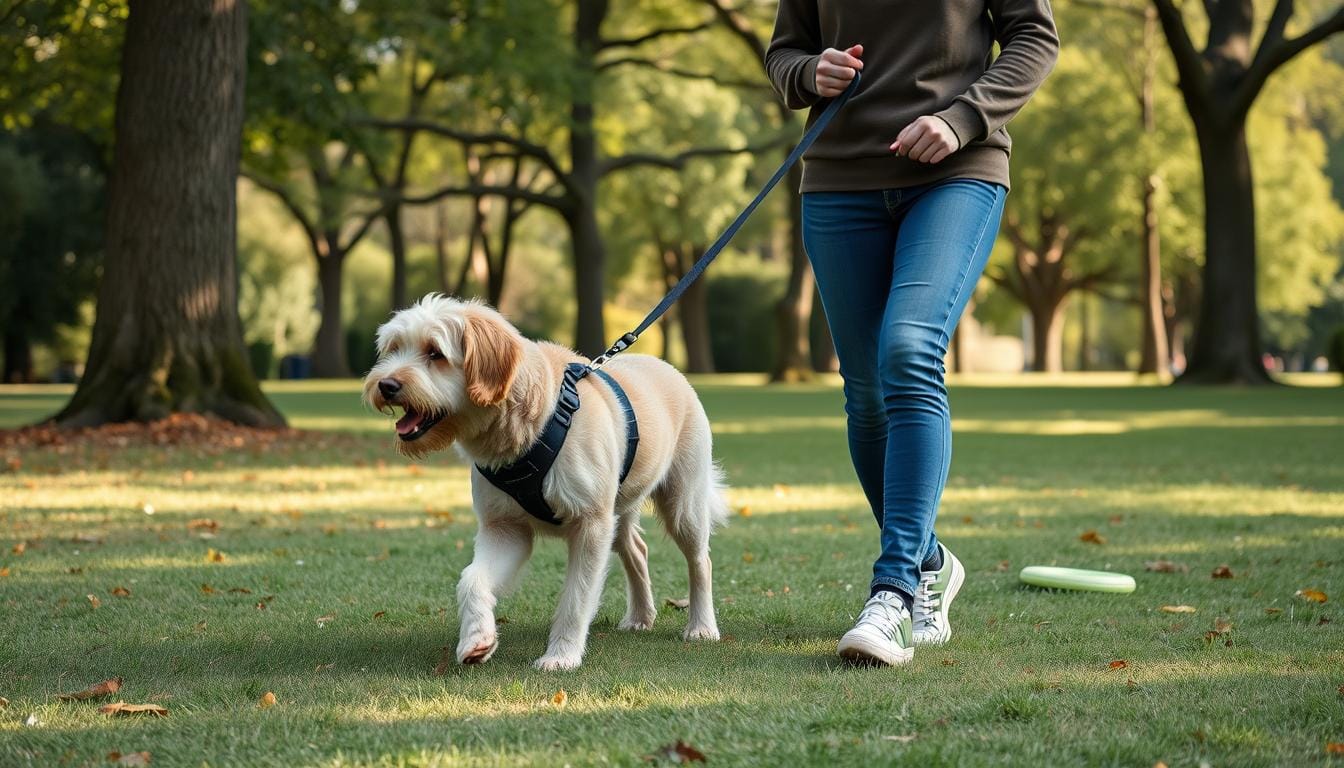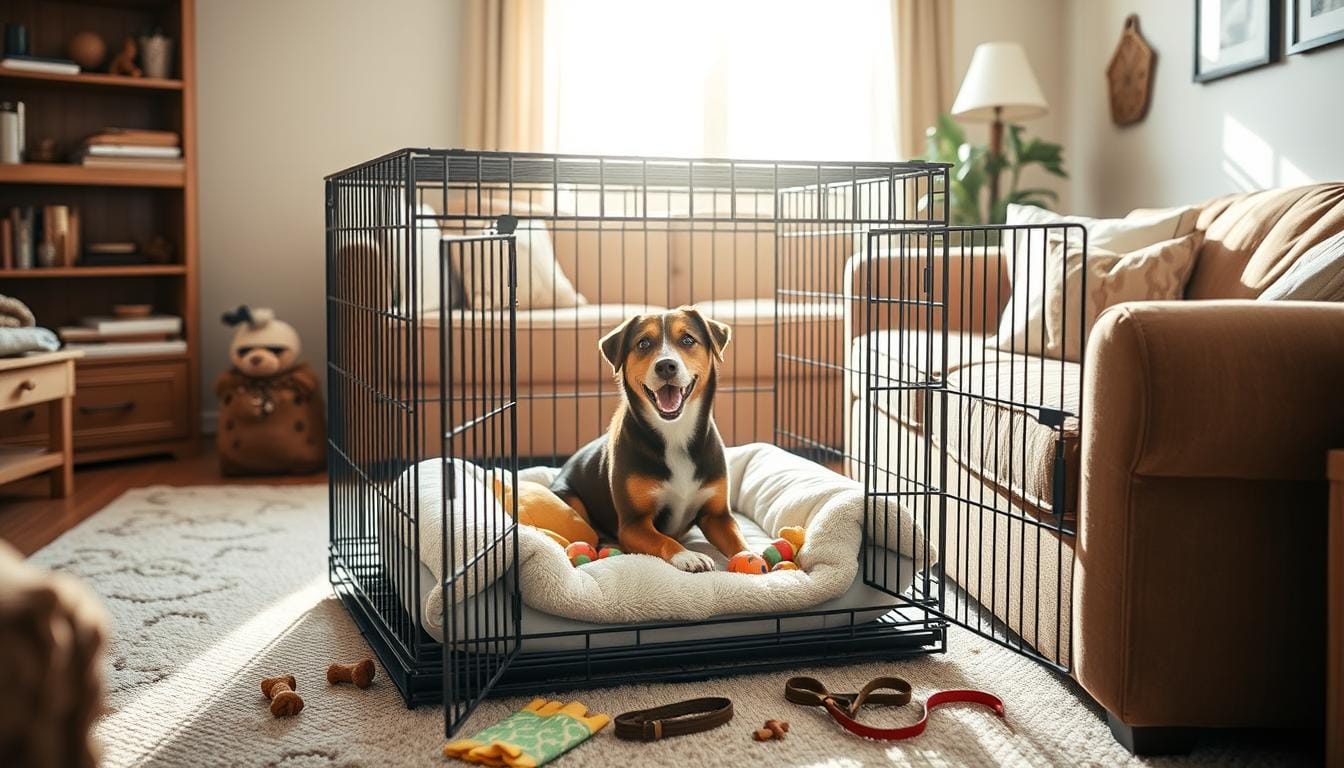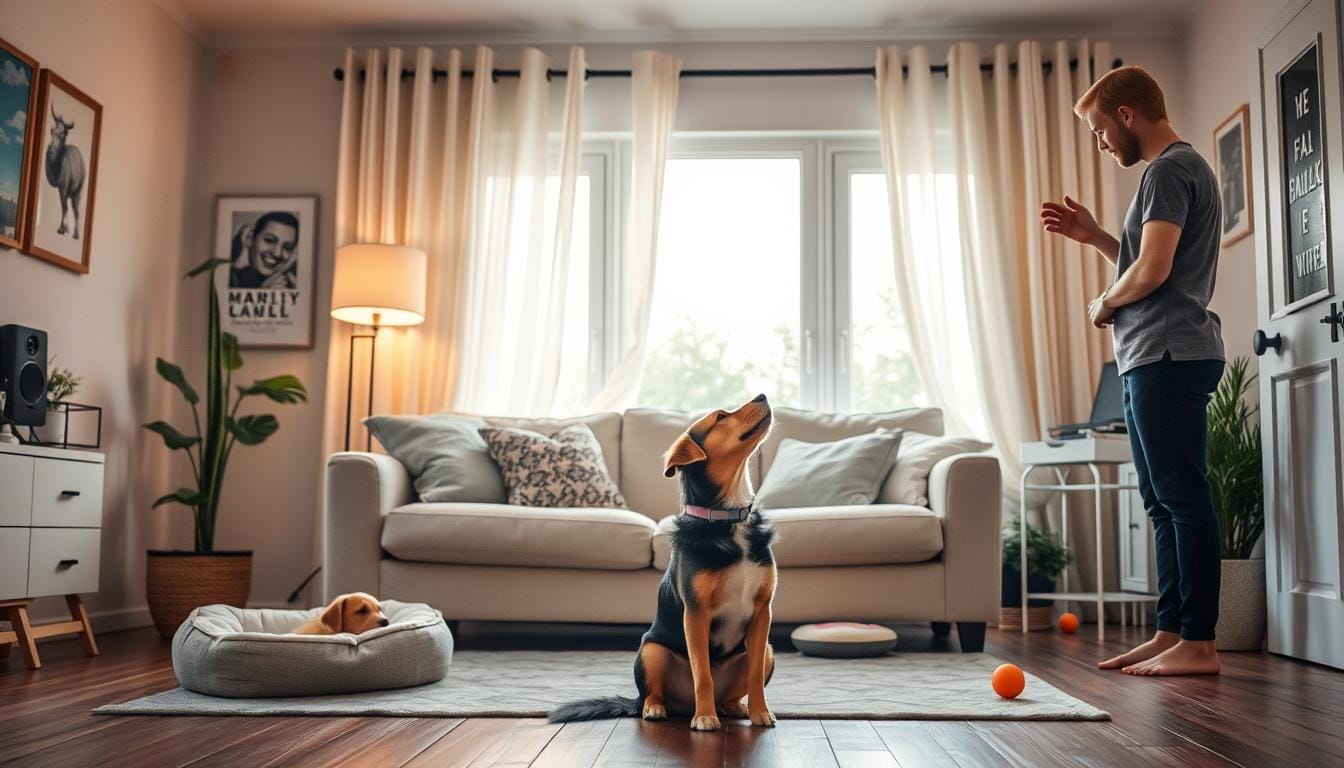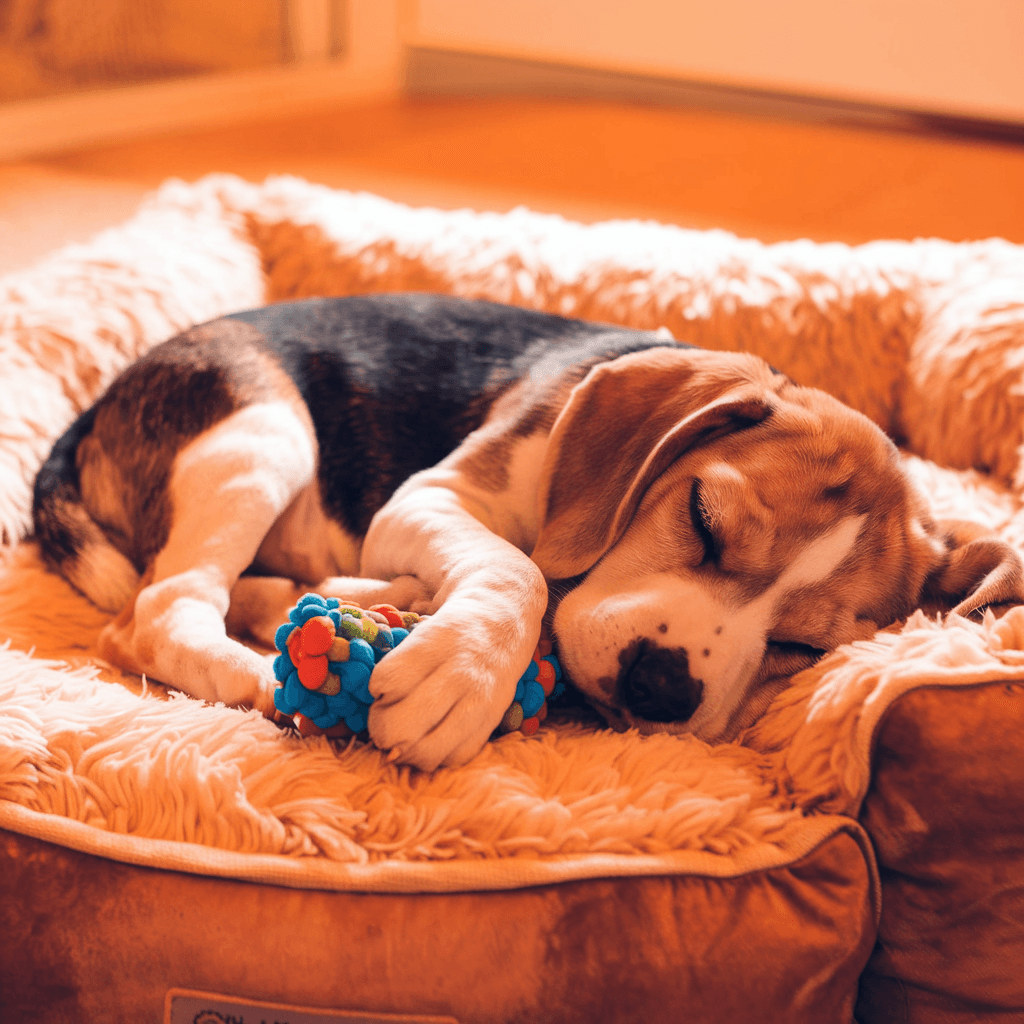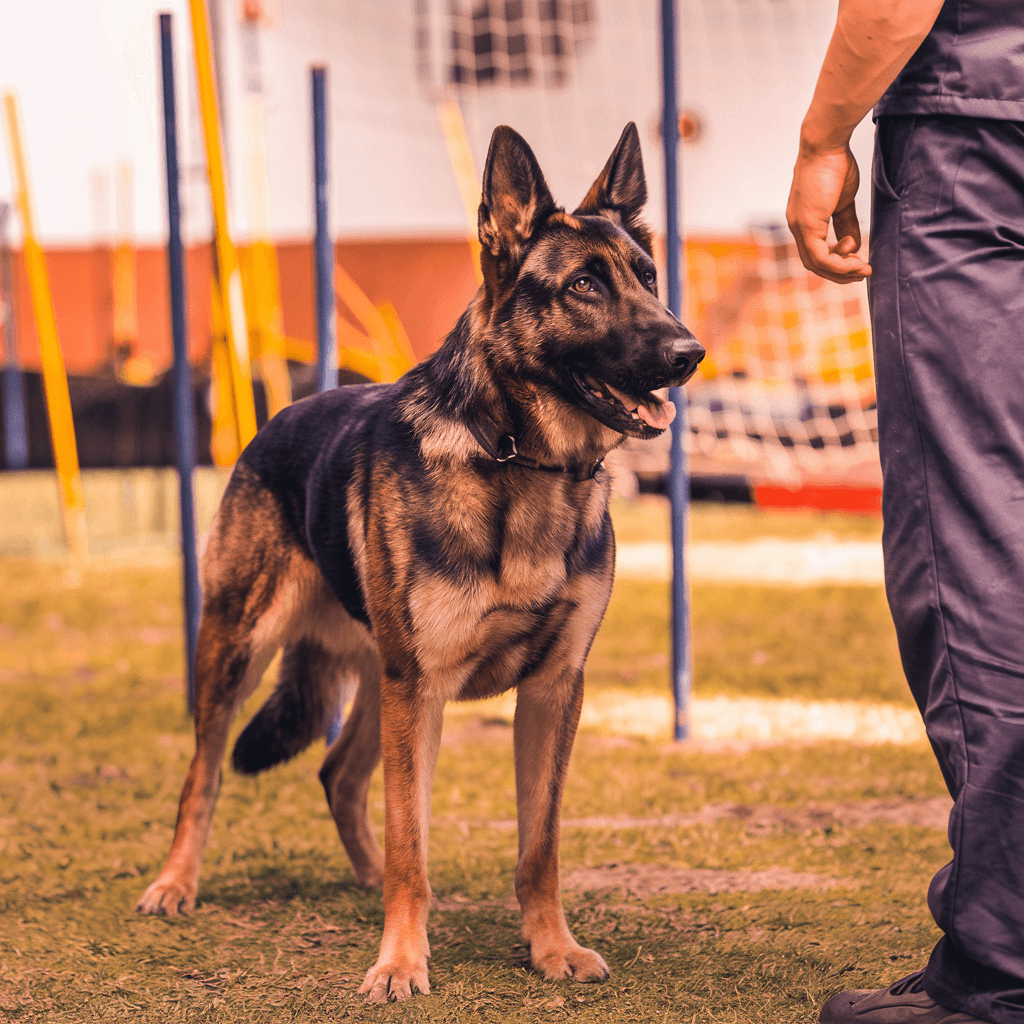Did you know dogs can sense human emotions instinctively? They can read our facial expressions and body language. They even notice changes in our scent. This lets them communicate with us in their own way, creating a strong bond.
Regular grooming is more than just making your dog look good. It’s crucial for their health and happiness. It helps distribute natural oils, prevents matting, and reduces shedding. We’ll share expert grooming tips to keep your dog’s coat, skin, and overall health in top shape.
Pet grooming is not just about looks; it’s a chance to bond with your dog. These sessions let you check for any health issues while soothing your pet. By following these grooming tips, you’ll keep your dog looking and feeling great.
Key Takeaways
- Regular grooming promotes overall dog health and well-being
- Grooming sessions help distribute natural oils and prevent matting
- Expert dog grooming techniques can reduce shedding
- Pet grooming strengthens the bond between dogs and their owners
- Regular checks during grooming can help detect health issues early
- Proper grooming contributes to a dog’s coat and skin health
The Importance of Regular Dog Grooming
Regular dog grooming is key for your pet’s health and happiness. It’s not just about looks; it’s vital for their well-being.
Health Benefits of Grooming
Dog grooming tips highlight its health benefits. Professional grooming can spot health problems early. This leads to quicker, better treatments.
Groomers check for infections, lumps, and skin issues. These might not be seen by owners.
Bonding Opportunities with Your Pet
Grooming is a great time to bond with your dog. Brushing strengthens your bond and prevents painful hair tangles. This can also improve your dog’s behavior and mental health.
Early Detection of Skin Issues and Abnormalities
Regular grooming helps find skin problems early. Skipping grooming can cause serious health issues. These include:
- Matted hair causing skin irritation and infections
- Flea and tick infestations hidden in hair mats
- Restricted blood circulation due to severe matting
| Grooming Task | Benefit |
|---|---|
| Brushing | Maintains healthy coat, distributes natural oils |
| Nail trimming | Prevents joint pain and alignment issues |
| Ear cleaning | Reduces risk of ear infections |
| Teeth brushing | Promotes good oral hygiene |
By adding these grooming practices to your routine, your dog will stay healthy, comfortable, and happy.
Essential Grooming Tools for Dog Owners
We’ve found 10 must-have dog grooming supplies to improve your pet grooming routine. With 15 years of experience, we know the right tools are key.
Quality brushes and combs are vital for your dog’s coat. The right one depends on your dog’s fur. Slicker brushes are best for long-haired breeds, while bristle brushes are better for short-haired dogs. Nail clippers are also essential for paw health.
Choosing a good dog shampoo is crucial. Pick one that matches your dog’s skin and coat type. A rubber grooming mitt can help remove loose fur and spread natural oils. For dental care, get a dog-specific toothbrush and toothpaste.
| Essential Tool | Purpose | Suitable For |
|---|---|---|
| Slicker Brush | Detangling, removing loose fur | Long-haired breeds |
| Bristle Brush | Smoothing coat, removing debris | Short-haired breeds |
| Nail Clippers | Trimming nails | All breeds |
| Dog Shampoo | Cleaning, conditioning | All breeds |
| Grooming Mitt | Removing loose fur, massaging | All breeds |
The right tools make grooming easier and more effective. They help spread natural oils, prevent matting, and spot skin issues early. Using these essential grooming tools keeps your dog looking and feeling great.
Establishing a Grooming Routine for Your Dog
Creating a regular grooming schedule is crucial for your dog’s appearance. We’ll discuss how often to groom, how to make it fun, and tips for adding grooming to daily tasks.
Frequency of Grooming Sessions
The grooming schedule varies based on your dog’s breed and lifestyle. Long-haired breeds, like Afghan Hounds, need frequent grooming. Short-haired dogs, such as Beagles, require less care. Here’s a quick guide:
- Long-haired dogs: Professional grooming every 4-8 weeks
- Short-haired dogs: Monthly baths
- All dogs: Nail trimming every 3-4 weeks
- Teeth brushing: Up to twice daily
Creating a Positive Grooming Experience
To make grooming enjoyable, start slow and use positive reinforcement. Give treats and praise during grooming. Remember, grooming is about bonding and keeping your pet healthy.
Incorporating Grooming into Daily Activities
Integrate grooming into your daily routine. Brush your dog’s coat regularly to control shedding and distribute natural oils. Wipe their paws after walks to remove dirt and check for any issues. These small steps can prevent bigger problems down the line.
“Regular brushing keeps dogs neat; daily brushing is even better.”
Grooming is more than just looks. It’s a chance to check for skin problems, ear infections, or dental issues. By establishing a solid grooming routine, you’re investing in your dog’s overall health and happiness.
Brushing Techniques for Different Coat Types
Dog coat care is key for your pet’s health and looks. Each coat type needs a special brushing method. Let’s look at the best pet grooming tips for different coats.

Short-haired dogs like Boxers and Beagles need a weekly bristle brush. This makes their coats shiny and healthy. For smooth-coated dogs, like Pugs and Labradors, a deshedding tool is helpful, especially when they shed.
Medium-haired dogs need more care. Australian Shepherds and Huskies should brush at least twice a week to avoid tangles. Long-haired dogs, like Shih Tzus and Maltese, need daily brushing to stop mats.
Wire-haired dogs are special. Terriers and Schnauzers need brushing twice a week. Groomers often use plucking or stripping to keep their coats non-shedding.
Curly-coated dogs, like Poodles and Bichon Frises, need weekly brushing. Use a leave-in conditioner after baths to keep their coats silky.
“Brushing helps prevent painful mats, reduces shedding, allows early detection of lumps or skin issues, and keeps dogs looking their best.”
Brushing before and after baths is crucial for all coats. It removes mats and stops tangling. By following these tips, your dog will stay healthy and happy.
Bathing Your Dog: Best Practices and Products
Bathing is key to keeping your dog clean and healthy. Most dogs need a bath every month or two. This depends on their coat type and lifestyle. Let’s explore the best ways to bathe your dog and pick the right products.
Choosing the Right Shampoo
Choosing the right shampoo is crucial for your dog’s skin. Always use dog-specific shampoos, as human products can harm their skin. For puppies, use puppy-specific shampoos that are gentle on their eyes.
Consider your dog’s coat type and any skin conditions when picking a shampoo.
Proper Bathing Techniques
Begin by brushing your dog to remove tangles and mats. Mix the shampoo with water for better lather and easier use. Wash your dog twice to remove all dirt and oil.
Be gentle around sensitive areas like ears, nose, and eyes. Rinse well to avoid skin irritation.
Drying Methods for Different Breeds
After bathing, towel-dry your dog and brush their coat as it dries. For breeds with long fur, use a dog-specific hairdryer on a medium or cool setting. Regular brushing during drying prevents mats and keeps the coat healthy.
“Bathing your dog is not just about cleanliness; it’s an opportunity to bond and check for any health issues.”
Pet grooming is more than just keeping your dog clean. It’s a chance to check for parasites, skin irritations, or unusual lumps. By following these tips, your furry friend will stay happy, healthy, and look their best.
Nail Care and Paw Maintenance
Nail care is key in dog grooming that many owners miss. Long nails can hurt a dog’s posture and walking. Trimming nails helps their muscles and stops joint problems.
There are many ways to groom nails, like clippers or Dremels. The Dremel 7700 is great for dog nails. Make sure to use treats to keep your dog happy during grooming.

For dogs with long quicks, try the Alternate Cut Method. Trim nails daily for a week, then every other day. Keeping up with this helps keep paws and nails healthy. Groomers say practice is important to get good at it.
| Nail Clipper Type | Best For | Ease of Use |
|---|---|---|
| Plier-style | Large dogs | Moderate |
| Guillotine | Small to medium dogs | Easy |
| Scissor-style | Small dogs and puppies | Easy |
| Grinder | All sizes, thick nails | Requires training |
Clip small pieces of the nail tip until you see the quick. Cutting into the quick can bleed, but it’s not serious. But, if it’s bad, you might need a vet. With the right care, your dog’s paws will stay healthy and comfy.
Dog Grooming Tips for Maintaining a Healthy Coat
A healthy coat is key for your dog’s well-being. Regular grooming keeps your pet looking good and healthy. Here are some tips to keep your dog’s coat in great shape.
Distributing Natural Oils
Brushing your dog’s coat regularly spreads natural oils. This makes their coat shiny and healthy. Long-coated breeds like Collies and Yorkies need daily brushing to avoid matting. Wire-haired breeds, such as Westies, also need regular brushing to keep their coat right.
Preventing Matting and Tangles
Matting can block oxygen to your dog’s skin, causing discomfort and health problems. Daily brushing is key for breeds that tangle easily, like Poodles and Bichon Frises. Use a detangling spray and gently work through knots with a slicker brush or comb.
Addressing Shedding Issues
Shedding is normal, but too much hair loss can be managed. Medium-coated breeds like Australian Shepherds and Golden Retrievers need more baths and brushings. Adding fatty acid supplements to their diet can help their coat health.
| Coat Type | Grooming Frequency | Special Care |
|---|---|---|
| Long-coated | Daily brushing | Use detangling spray |
| Wire-haired | Regular brushing | Maintain coat texture |
| Smooth-coated | Minimal maintenance | Occasional brushing |
Bathing your dog every 4 to 6 weeks removes toxins and allergens. By following these grooming tips, your dog’s coat will stay healthy and beautiful all year.
Ear Cleaning and Eye Care for Dogs
Keeping your dog’s ears and eyes clean is key to their happiness and health. Here are some important tips for grooming your dog’s ears and eyes.
How often you clean your dog’s ears depends on their breed. Some dogs need more cleaning, especially if they get ear infections often. Use a good ear cleaner that fights bacteria or fungus. But don’t clean too much, as it can irritate their ears.
To clean your dog’s ears:
- Position your dog comfortably
- Apply ear cleaner to a cotton ball
- Gently wipe the visible part of the ear canal
- Massage the base of the ear to distribute the cleaner
- Let your dog shake its head to remove excess
For eye care, clean around your dog’s eyes during baths. Their eyes should be bright and clear. If they blink a lot or rub their eyes, it might mean they have an infection.
| Breed | Eye Care Concerns | Recommended Care |
|---|---|---|
| Shih Tzu | Prone to eye staining | Regular cleaning, tear stain remover |
| Pug | Bulging eyes, tear staining | Daily eye wipes, lubricating drops |
| White-coated breeds | Visible tear staining | Frequent cleaning, dietary adjustments |
Pet grooming is a great way to bond with your dog. Give them treats and praise to make it a fun experience. If your dog’s ears or eyes keep having problems, see a vet for help.
Dental Hygiene: Keep Your Dog’s Smile Bright
A bright smile isn’t just for humans! Dental hygiene is key in dog grooming tips. Up to 80% of dogs show dental disease signs by age three. So, start early and keep up with oral care.
Brushing Techniques
Brush your dog’s teeth daily or 3-4 times a week. Pick a toothbrush that fits your dog’s size. Smaller breeds might like finger brushes, while larger dogs need long-handled ones.
Pay special attention to the gum line where bacteria hide. For Labrador Retrievers, daily brushing is crucial. It helps prevent plaque, especially on back molars.
Dental Chews and Toys
Add vet-recommended dental chews to your grooming routine. These chews clean teeth and boost oral health between brushings. For Labradors, choose chews that fit their size and diet.
Crunchy kibble can also help reduce plaque buildup.
Professional Dental Cleaning
Even with good home care, professional cleanings are a must. Regular vet visits help catch and fix dental problems early. Look out for bad breath, discolored teeth, or eating trouble in your Labrador or any breed.
Remember, a healthy mouth is key to overall health. So, dental care is a vital part of dog grooming tips.
Addressing Common Grooming Challenges
Dog grooming tips often focus on the ideal scenario, but pet grooming can present unexpected hurdles. We’ve compiled a list of common challenges and practical solutions to help you navigate these issues with ease.
Matted fur is a frequent problem, especially for long-haired breeds. Regular brushing is key to prevention. For existing mats, use a detangling spray and work through knots gently with a wide-toothed comb.
Excessive shedding can be managed with consistent brushing using the right tools. A deshedding brush can significantly reduce loose fur, keeping your home cleaner and your dog more comfortable.
Many dogs feel anxious during grooming sessions. Studies show that up to 70% of dogs exhibit resistance or fear towards grooming. To address this:
- Start with short, positive grooming experiences
- Use treats and praise for reinforcement
- Gradually increase session duration as your dog becomes more comfortable
Nail trimming is often dreaded by both dogs and owners. Introduce the process slowly, rewarding your dog for allowing you to touch their paws before attempting to trim.
| Grooming Challenge | Prevalence | Solution |
|---|---|---|
| Resistance to grooming | 70% of dogs | Positive reinforcement, gradual exposure |
| Aggression during grooming | 20% of dogs | Professional training, desensitization |
| Avoidance behavior | 15% of dogs | Create a calm environment, use distractions |
| Stress signs (barking, whining) | 10% of dogs | Short sessions, frequent breaks |
Remember, patience is key when addressing grooming challenges. With consistent practice and positive experiences, most dogs can learn to enjoy their grooming routine.
Professional Grooming vs. Home Grooming
Pet owners often choose between professional grooming and doing it themselves. About 60% prefer professional grooming, while 40% do it at home. Professional groomers have the skills and tools needed for complex grooming.
When to Seek Professional Help
Professional groomers are key for breed-specific cuts and severe matting. Dogs usually go 4-6 times a year. Each visit lasts 2-3 hours and costs $50-$90, based on size and coat.
For those worried about costs, home grooming kits are cheaper in the long run.
Benefits of Professional Grooming Services
Professional groomers provide deep cleaning and precise cuts. They use top-notch tools and can spot health issues early. This is vital for catching skin problems or other issues.
About 75% of pet owners are happier with professional grooming than DIY.
Tips for Maintaining Grooming Between Appointments
To keep your dog looking great between visits, brush them regularly and practice basic hygiene. About 65% find DIY grooming time-consuming. Yet, 80% say it reduces pet stress.
By following these tips, you can keep your pet’s coat in top shape and save on professional visits.







